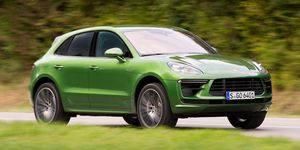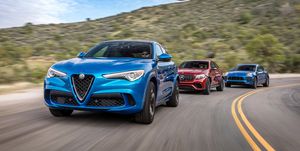
James LipmanCar and Driver
A lot of small SUVs hint at sportiness, but the 2020 Porsche Macan Turbo actually delivers. It’s not merely sporty; it’s wicked quick. The handling isn’t just performance oriented but sticky, like duct tape on bare skin. It’s almost a shame to mention the Macan Turbo in the same breath as everyday compact crossovers such as the Honda CR-V and Toyota RAV4, even if in size the Macan is close to those workaday appliances. The Macan Turbo is a superhero of an SUV that leaves lesser, small crossovers staring in awe.
The Macan Turbo’s big change for the 2020 model year is the adoption of a twin-turbocharged 2.9-liter V-6. Rated at 434 horsepower, this 90-degreee V-6 places its turbo in the valley between the cylinder banks in order to shorten up exhaust-gas pathways to the impellers and provide nearly instantaneous boost. That horsepower number is a sizeable one, but just as impressive is the engine’s 405 lb-ft of torque that stretches from 1800 to 5500 rpm.
Previously, Porsche fitted the the Macan Turbo with a standard twin-turbo 3.6-liter V-6 good for 400 horsepower. An optional $10,500 Performance package bumped that figure to 440 horses. That 3.6-liter was a wonderful and seductive powerplant that delivered a silken slam. Though it’s down six ponies and 37 lb-ft of torque compared to the previous 3.6-liter, the new 2.9-liter is a touch more forgiving, a touch quieter at cruise, and has a touch more personality. Best of all, buyers don’t need to tack on an additional pricey option package to get its full strength. Well, at least not yet. The Panamera GTS uses a version of this engine that makes 453 horsepower, so a future Performance package isn’t out of the question.
The transmission remains Porsche’s sublime seven-speed dual-clutch PDK automatic. Included with the $1360 Sport Chrono package is Porsche’s launch-control system. When stopped, engage the brake and accelerator pedals and watch the engine climb to about 4600 rpm. Release the brake and drop the hammer. It’s an utterly beguiling launch; a seat-crushing adventure that builds speed and lifts emotions simultaneously. The all-wheel-drive Macan Turbo at full whack is a feel-good happy pill reengineered as something that looks like a compact crossover.
With our test gear aboard, the hot Macan’s blast to 60 mph took 3.5 seconds and 100 mph came up in 9.6 seconds. The quarter-mile steamed by in 12.2 seconds at 112 mph. The brutality of the launch made it feel even quicker than that. However, that pace is a tenth or so of a second slower in all measurements than the previous Turbo with the Performance pack that narrowly lost a comparison test to the Alfa Romeo Stelvio Quadrigfolio. The new Turbo model isn’t the quickest in its class. Both the 503-hp BMW X3 M and the equally powerful Mercedes-AMG GLC63 S coupe sprint to 60 mph a smidge quicker and return quarter-mile times that start with 11s. No, this Porsche’s performance is more nuanced.
Wonderfully Sorted
Riding on 21-inch Michelin Latitude Sport 3 summer tires—sized 265/40R-21 in front and 295/35R-21 in back—the Macan Turbo should have a stiff ride and sudden drop-off handling limits. But the optional adaptive air springs and Porsche Active Suspension Management (PASM) system work magic to keep the handling tidy even under totally stupid cornering loads. The Macan Turbo also has the advantages of Porsche’s torque-vectoring technology and a long 110.5-inch wheelbase relative to its 185.0-inch overall length. Our test car’s measured lateral grip (0.93 g) and stopping ability from 70 mph (156 feet) were essentially the same as the previous model’s with the Performance package.
The cruising ride in this tall, compact machine puts many large sedans to shame. The wheel motions are perfectly controlled, the body stays flat to the road surface, and at the limit the Macan Turbo transitions sweetly into mild understeer. This is a machine that won’t let you make a bad move until you’ve defeated a phalanx of technology built to save you from yourself.
For an SUV, the steering is transcendent, like an altered state of consciousness with less karmic kickback. Rear-seat legroom in the latest Macan remains stingy, and there’s not much in the way of storage in the way-back. But otherwise the Macan Turbo’s interior is super swank. The front seats adjust in more ways than your body does, and the steering wheel itself is perfectly sized and grippy. But it’s the new 10.9-inch Porsche Communication Management (PCM) touchscreen that the company is shouting the most about and which, thankfully, still has a number of functions controlled by physical buttons.
Not to fight Porsche’s product messaging, but if you’re obsessed with touchscreen size, this probably isn’t the small SUV for you. What makes the Macan Turbo special is that it’s among the best high-riding driving machines available at any price.
With that in mind, the Macan Turbo starts at $84,950. Although that price is more than $12,300 greater than the next-rung-down Macan, the GTS, it still undercuts what the previous Turbo cost when fitted with its Performance package. The lightly optioned example we drove carried a $94,120 total chit. Add in a few options such as a big sunroof, and this is easily a six-figure compact crossover. That it’s one of our favorites helps temper the financial pain it demands.
Source: Reviews - aranddriver.com






